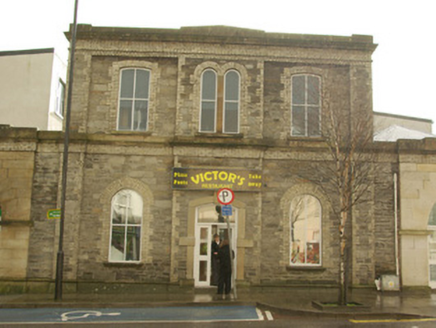Survey Data
Reg No
40838019
Rating
Regional
Categories of Special Interest
Architectural, Historical, Social
Original Use
Market building
Historical Use
Office
In Use As
Restaurant
Date
1860 - 1870
Coordinates
214144, 394642
Date Recorded
04/02/2008
Date Updated
--/--/--
Description
Attached three-bay two-storey former market house, built 1862, having central shallow full-height single-bay breakfront, projecting full-height pilasters (on square-plan) to the corners of the main elevation (north), and with screen walls to either side (east and west) of the main elevation having integral round-headed carriage-arches with ashlar sandstone surrounds. Central section now in use as a restaurant with carriage-arch to the west now infilled to provide kitchen area. Formerly in use as offices. Former blocks to the south now demolished with modern structures arranged around central courtyard to the south. Hipped natural with central shallow pediment to central breakfront, cut stone eaves cornice, cut stone blocks to either end (east and west), and with surviving sections of cast-iron rainwater goods; raised stepped cut stone coping to screen walls having yellow brick eaves course with moulded cut stone cornice over. Roughly squared and coursed rubble stone walls over projecting battered cut stone plinth having pulvinated cut stone stringcourse over, yellow brick eaves course with yellow brick eaves course, flush yellow brick block-and-start quoin detailing to corners of pilasters and breakfront, and yellow brick course above ground floor openings having flush ashlar sandstone course over with moulded sandstone cornice; smooth rendered ruled-and-lined finish to west elevation of main block at first floor level. Roughly squared and coursed rubble stone construction to screen walls having projecting full-height squared rubble stone pilasters to outer corners with flush yellow brick block-and-start quoin detailing to the corners. Ashlar sandstone surrounds to carriage-arches having projecting cut stone stringcourses at arch springing point; wrought-iron double-gates to carriage-arch to the east, carriage-arch to the west now infilled with modern fixed-pane window fittings and square-headed doorway. Round-headed window openings to outer bays of main block at ground floor level with shallow segmental-headed window openings over at first floor level having stone sills, flush yellow brick block-and-start surrounds, and with replacement fixed-pane two-over-two pane window fittings; paired round-headed window openings to central bay at first floor level having stone sills, flush yellow brick block-and-start surrounds, and with replacement fixed-pane one-over-one pane window fittings. Segmental-headed doorway to centre bay of main block having ashlar sandstone surround with keystone detail, plinth blocks, ashlar sandstone step, and with replacement door, sidelight and overlight. Road-fronted to the centre of Main Street, Ballybofey. Carriage-arch to the east gives access to former market yard.
Appraisal
Despite some modern alterations and additions, this impressive and well-proportioned former market house retains much of its early character and form to the front elevation (north). The slightly projecting central breakfront and classical detailing lend it an air of authority and a commanding presence in the streetscape that is befitting of an important civic structure. The round-headed openings and the raised cut stone parapet lend it a vaguely Italianate architectural character that was en vogue for the design of many civic buildings, banks etc. at the time of construction. The contrast between the grey dimension stone and the yellow brick detailing creates a pleasing visual and tonal variation to the main elevation. The central doorway with dressed ashlar limestone surround to the breakfront, and the paired round-headed window openings over, creates a strong central focus. The former carriage-arches to either side of the main elevation are well-crafted using high quality ashlar sandstone masonry, and are clearly the work of skilled masons. The presence of a fine market house indicates a level of economic prosperity and commercial confidence in Ballybofey at the time of construction. The present complex replaced an earlier market house in Ballybofey, which was located to the west of the present site and which was in existence in 1837 (depicted on the Ordnance Survey first edition six-inch map). The present market house was built to designs by John Guy Ferguson (died 1901), a Derry City born architect who worked extensively in Donegal in the 1860s, designing the Presbyterian churches at nearby Raphoe (1862), at Buncrana (1862), Moville (1862), and the Church of Ireland church at Burt (1868-9), amongst other commissions. The main contractor\builder involved in the construction of the market house was a McClelland, also of Derry. There were originally two long buildings to either side of the yard to the rear, running perpendicular to the front elevation, now demolished or heavily altered. Slater’s Directory of 1881 records that a market for grain, pork and butter was held every Saturday, a market for flax each Friday, while the edition of 1894 records that a market for oats, pork and butter was held here every Thursday. This fine building is one of the more important elements of the built heritage of Ballybofey, and is an integral element of the built heritage and social history of the town.















